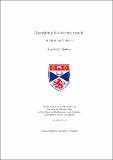Files in this item
Quantifying biodiversity trends in time and space
Item metadata
| dc.contributor.advisor | Buckland, S. T. (Stephen T.) | |
| dc.contributor.advisor | Magurran, Anne E. | |
| dc.contributor.advisor | Illian, Janine | |
| dc.contributor.author | Studeny, Angelika C. | |
| dc.coverage.spatial | 259 | en_US |
| dc.date.accessioned | 2013-03-21T16:48:07Z | |
| dc.date.available | 2013-03-21T16:48:07Z | |
| dc.date.issued | 2012-11-30 | |
| dc.identifier.uri | https://hdl.handle.net/10023/3414 | |
| dc.description.abstract | The global loss of biodiversity calls for robust large-scale diversity assessment. Biological diversity is a multi-faceted concept; defined as the “variety of life”, answering questions such as “How much is there?” or more precisely “Have we succeeded in reducing the rate of its decline?” is not straightforward. While various aspects of biodiversity give rise to numerous ways of quantification, we focus on temporal (and spatial) trends and their changes in species diversity. Traditional diversity indices summarise information contained in the species abundance distribution, i.e. each species' proportional contribution to total abundance. Estimated from data, these indices can be biased if variation in detection probability is ignored. We discuss differences between diversity indices and demonstrate possible adjustments for detectability. Additionally, most indices focus on the most abundant species in ecological communities. We introduce a new set of diversity measures, based on a family of goodness-of-fit statistics. A function of a free parameter, this family allows us to vary the sensitivity of these measures to dominance and rarity of species. Their performance is studied by assessing temporal trends in diversity for five communities of British breeding birds based on 14 years of survey data, where they are applied alongside the current headline index, a geometric mean of relative abundances. Revealing the contributions of both rare and common species to biodiversity trends, these "goodness-of-fit" measures provide novel insights into how ecological communities change over time. Biodiversity is not only subject to temporal changes, but it also varies across space. We take first steps towards estimating spatial diversity trends. Finally, processes maintaining biodiversity act locally, at specific spatial scales. Contrary to abundance-based summary statistics, spatial characteristics of ecological communities may distinguish these processes. We suggest a generalisation to a spatial summary, the cross-pair overlap distribution, to render it more flexible to spatial scale. | en_US |
| dc.language.iso | en | en_US |
| dc.publisher | University of St Andrews | |
| dc.subject | Biodiversity | en_US |
| dc.subject | Diversity measures | en_US |
| dc.subject | Goodness-of-fit statistics | en_US |
| dc.subject | Simpson's index | en_US |
| dc.subject | Shannon index | en_US |
| dc.subject | Geometric mean | en_US |
| dc.subject | British breeding birds | en_US |
| dc.subject | Cross-pair overlap distribution | en_US |
| dc.subject | Point pattern | en_US |
| dc.subject | Detection probability | en_US |
| dc.subject.lcc | QH541.15B56S8 | |
| dc.subject.lcsh | Biodiversity--Measurement | en_US |
| dc.subject.lcsh | Biodiversity--Statistical methods | en_US |
| dc.subject.lcsh | Goodness-of-fit tests | en_US |
| dc.subject.lcsh | Bird populations--Estimates--Great Britain--Case studies | en_US |
| dc.title | Quantifying biodiversity trends in time and space | en_US |
| dc.type | Thesis | en_US |
| dc.contributor.sponsor | University of St Andrews. | en_US |
| dc.contributor.sponsor | National Centre of Statistical Ecology (NCSE) | en |
| dc.type.qualificationlevel | Doctoral | en_US |
| dc.type.qualificationname | PhD Doctor of Philosophy | en_US |
| dc.publisher.institution | The University of St Andrews | en_US |
| dc.publisher.department | Centre of Research into Ecological and Environmental Modelling, School of Mathematics and Statistics | en_US |
This item appears in the following Collection(s)
Items in the St Andrews Research Repository are protected by copyright, with all rights reserved, unless otherwise indicated.

